Taylor Jones woke up in a panic. He felt pain in his chest, struggling to breathe while lying in his bed. His mind quickly turned to the worst: he thought he was having a heart attack.
Yet the pressure subdued as he positioned himself upright. His lungs filled with air, he closed his eyes and he went back to sleep. But it was then he realized what had been lingering for weeks was severely affecting him.
When Jones first started to feel ill, he thought he had the flu. He had body aches and cold sweats in the middle of the night but no symptoms of congestion, fever or cough. He never felt sick, but that one night late into the 2022 season signaled a trip to the emergency room.
Doctors ran tests on Jones, not knowing what was causing his irregular symptoms. They first came to the conclusion Jones had been suffering from costochondritis — the build up of inflammation in the cartilage that connects a rib to the breastbone.
Jones took a steroid pack to ease the pain from the inflammation. It worked. The heaviness on his chest went away, until the final week of the season.
With the San Francisco Giants, Jones spent the final few weeks of the year at the organization’s spring training complex in Scottsdale, Arizona. Staying readily available if the big league club needed an extra man down the stretch, Jones felt the pain in his chest re-emerge.
What Jones suffered from didn’t have to do with stress or pressure put on his ribs; he suffered from extensive pulmonary embolisms in his lungs — also known as blood clotting. His second trip to the hospital told him that as doctors ran more tests on his condition.
Jones was put on a blood thinner, which immensely addressed his complications, but by the time free agency rolled around that winter, organizations wanted him off the medication to see if he was cleared to return to the game.
“I think mostly what they’re worried about is any head contusion,” Jones said. “If you get hit in the head at all, you could bleed in your brain and people can die from that, or like internally, if you get hit hard in the abdomen area and one of my organs was to start bleeding, it’s not a good situation. So they originally just wanted me off the thinner just because it was a liability risk.”
Doctors cleared Jones to play for the 2023 season. He signed a minor-league contract with the Los Angeles Angels and took a step forward in attempting a comeback to the major leagues with his third organization.
Halfway through his season with Triple-A Salt Lake, Jones had a scheduled checkup with doctors. He felt completely normal, thinking nothing would warrant it, but after a mid-week game in early June, he met with doctors for a preemptive appointment.
“Unfortunately or fortunately, depending on how you’re looking at it, when I went in, they found more clotting in my lungs,” Jones said. “They had shut me down because the doctors put me on the blood thinner and they told me that this time that I needed to stay on it for good.”
That was it.
Jones was put back on blood thinners, placed on the injured list and shut down indefinitely. He was in a position where no one knew what was causing his condition.
After putting Jones back on medication, doctors found an abnormality in his shoulder that they had been affecting him, thinking Jones had thoracic outlet syndrome — the compression of blood vessels or nerves. Jones wanted a second opinion and received it from Dr. Gregory J. Pearl in September.
Pearl found no traces of Jones’ blood clotting to TOS, meaning he didn’t need the surgery previous doctors recommended. Originally, Jones thought, with the procedure, a return would happen in the final weeks or months of the season, but it never came, with his contract expiring in November.
That offseason at his home in Las Vegas, Jones met with new doctors. He wanted to find the true cause of his blood clots. They ruled out anything genetically but turned to theories as to why it came back.
Doctors didn’t want Jones, who was 29 years old at the time, to rely on blood thinners for the rest of his life, especially with him pursuing a new contract in professional baseball.
Through it all, though, the Houston Astros knew what was going on. The organization that drafted him in 2016, keeping him around until September 2022, had monitored his status but not for a players’ contract.
Jones weighed the option of sitting out a year to let things settle, giving medical professionals more time to evaluate him, but then he thought harder. He didn’t have his best season in 2023, he was entering the next year at 30 years old and he didn’t want to be away from the game.
Jones read the writing on the wall. In late November, early December, he took an offer with the Astros as a hitting coach in the Florida Complex League, realizing he wanted to give back to the game and coach those in a similar position as him eight years ago.
“It was pretty hard to not jump on this opportunity given the circumstances of where I was at,” Jones said. “A little bit of the passion for playing had diminished.
“I don’t know if it was just due to health issues, if I was trying to get my brain wrapped around it or if that was just how I was feeling around playing as a whole anyways, but coaching has always been something that I wanted to pursue at the end of my career.”
While filling in for manager Mickey Storey in late June, Astros quality control coach Jason Bell, who served as the organization’s minor league field coordinator last year, spoke with Jones when Triple-A Sugar Land took to Salt Lake. The meeting brought Jones’ 2022 World Series ring to him, but it also struck a conversation on what had been holding him out.
Bell talked with Jones then about the health complications that sidelined him only two weeks before. Bell didn’t want to bring up what the future held beyond playing because of how much he respected Jones’ abilities as a player.
Bell first crossed paths with Jones in 2017 at Low-A Quad Cities as a development coach. There, Jones wasn’t the best player in the lineup. He hit towards the bottom of the order behind a cast of future major leaguers, but even in his own right, he displayed qualities that contributed to his rise through the system to the big leagues.
“I think the one thing that I noticed right away from him was just how emotionally mature he was in a way where it was definitely going to maximize his capabilities as a baseball player,” Bell said. “You could just feel that every bit of talent that he was going to have was going to be squeezed out, and fast forward a couple of years, he does that and he gets to the major leagues. And you start to think to yourself, ‘I’m not surprised.'”
When the Astros had an opening this offseason, Bell knew Jones was the perfect candidate. He saw his former player’s qualities as a listener and learner as the perfect mold to be a coach and mentor for the organization. Jones, who was always open to change, displayed the characteristics of a multi-perspective leader the Astros sought out.
The last thing Bell wanted to do, as a coach, was talk or convince someone out of playing. Before even presenting an offer, he talked with Jones about where he stood on his future. He recognized the small window of playing and the forever he and Jones would have for coaching.
Bell reached out to Jones in the weeks following the end of his tenure in the Angels’ system. He didn’t propose coaching at first, asking about what opportunities he was looking for. The conversation bled into that, though, as Jones became a candidate for an opening.
“I’m very confident that he’s going to become a very good coach quickly,” Bell said. “It’s just now he’s standing on the other side of the conversation, and so just like myself or anybody who ever gets into coaching, there’s always that buffer period, where it just takes a little bit of time to feel comfortable in it.”
To Jones, the opportunity presented itself from a coach and an ensemble of supporters that knew him well over six seasons in the organization.
“I was thinking there’s probably no better person to be a coach than Taylor Jones,” Bell said. “I always knew, even from the moment I met him, that he was going to be a good coach, but I wanted his coaching career to start as late as possible because I want him to play as long as possible.”
Jones felt like he joined the Astros in 2016 with a limited skill set, but through the organization, he always absorbed information well, holding strong relationships with staff members and teammates en route to the major leagues.
“I understand how they go about player development,” Jones said. “I think it’s something that benefited me greatly. I don’t think I would have gotten to where I got my career if it wasn’t for the player development staff and what they were implementing at that time.”
Deep down, Jones knew it was time to say goodbye to playing. If he didn’t, he would’ve held onto a dream still affected by a health complication. He enjoyed what baseball offered him as a player, but the urge to be a part of a team pushed him to accept a coaching position five months after his final professional at-bat.
“I felt this need to want to serve and give back to the game,” Jones said. “I don’t know if you want to call it God or the universe or the signs that be. I just felt the accumulation of everything presented an opportunity that made the most sense to me.”
Jones is set to join the Astros in February at spring training in West Palm Beach, Florida, working alongside his former coaches and assisting in the development of familiar faces and the future of the organization.
“You will not find a single person in the organization who doesn’t absolutely love Taylor Jones,” Bell said. “And it’s just like the genuine qualities that he gives off. … It’s just he makes the people around him better.”
Jones is still on blood thinners to this day. Although moving to Florida later this month, he’s continuously working with doctors in Las Vegas to find a way to live comfortably without the medication.


















